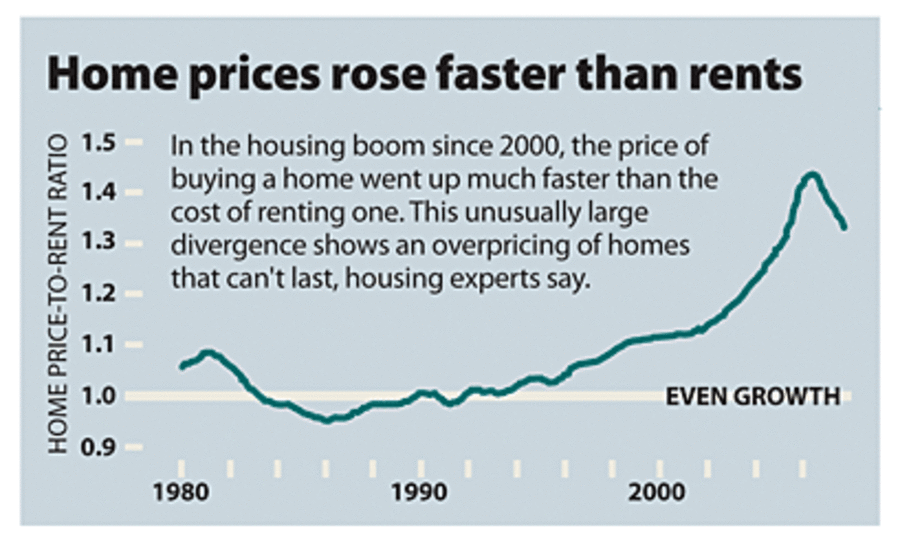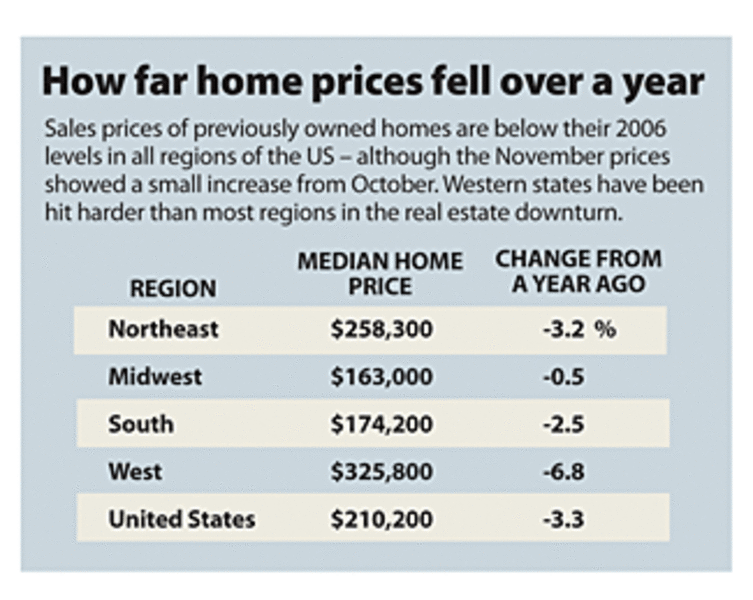Home prices: Where's the bottom?
Loading...
One of the big questions that hangs over both the US economy and individual Americans in 2008 is a seemingly simple one: What's a house really worth?
The problem is, the housing market is in an unusually volatile state. Home prices are posting rare declines in many cities, and potential buyers and sellers alike are wondering where the market will bottom out.
In this decade's raging real estate market, property values became untethered from reality, economists say. Home prices rose much faster than people's incomes or the rent that houses could earn when leased.
Now, home prices are in the process of moving back toward a more normal relationship with those fundamentals, housing experts say. But that doesn't mean that home prices will travel a predictable route.
"We think [the median price] is going to drop probably about 10 percent," says Patrick Newport, a housing economist at Global Insight in Lexington, Mass.
But "there are many possible paths" to a new equilibrium, he adds.
Some paths might involve more of a rise in rents or personal incomes – and a smaller decrease in home prices – over the next several years, for example. In effect, that would allow home prices to stay fairly flat while other factors adjust.
On Dec. 31, for example, the National Association of Realtors gave its latest numbers on monthly sales volumes and prices for previously owned homes. It showed that over the past three months, both sales volume and prices have been fairly stable.
"Near term, existing-home sales should continue to hover in a narrow range, just as they have since September, and that's good news because it'll be a further sign that the housing market is stabilizing," Lawrence Yun, the trade group's chief economist, said in releasing the data.
America's median home price is now $210,200, down 3.3 percent from a year ago but 7.6 percent above its 2004 level.
Where prices head next could affect an economy that has hit a slow patch and that confronts a high risk of recession. Perhaps most significant, falling home prices could further exacerbate a foreclosure rate that is already much higher than in past housing downturns. The further home prices fall, the greater will be the number of recent buyers whose homes are worth less than what they owe on mortgages. This creates a volatile situation in which these "under water" buyers may opt to walk away from their homes and find a cheaper rental.
A rising foreclosure rate could push prices down faster, because a foreclosed home tends to sell at a much lower price than the same home sold under a typical broker listing.
Rents vs. home prices
Regardless of foreclosures, however, many economists expect further home-price declines. That's because prices surged so far ahead of incomes and rents during a long boom earlier this decade.
"Historically there's a relationship between value of a house and equivalent rents," says Bob Walters, chief economist at Quicken Loans in Livonia, Mich.
After two decades when home prices and rents changed at fairly similar paces, soaring home prices since 2000 have pushed the price-to-rent ratio about 33 percent above its long-run average, according to research by Merrill Lynch in New York.
For several decades, home prices have tended to rise faster than average wages. But the period since 2000 saw an even quicker rate of increase.
"Prices don't necessarily have to plunge," says Mark Zandi, chief economist at Moody's Economy.com in West Chester, Pa. "If rents and incomes increase by 5 percent per annum … we would be back to those historical norms" in about five years.
"More likely, prices fall 10 percent" or so, he says. That would restore balance to the housing market sooner.
Currently, the for-sale market has a 10-month supply of previously owned homes and a nine-month supply of newly built homes.
"They don't ring a bell at the top or the bottom" of a real estate cycle, Mr. Walters says. But a balanced market has about a six-month supply of homes.
"As you see fewer and fewer 'for sale' signs, that's an indicator," he says. "Maybe one per block" should be typical.
Just as stock market investors look at the ratio of a company's share price to its earnings, home buyers can look at the price-to-rent ratio.
Prices have outrun rents by a greater margin in some cities than in others, Merrill Lynch found in its research. Phoenix, Washington, New York, Miami, and West Coast cities lead the pack of high fliers. Prices in many inland cities don't look far out of kilter. But every region of the country is affected.
During the boom, borrowers and lenders both began believing that the rise in property values would never end.
Some evidence seemed to support this view. By one government index, home prices still haven't had an annual decline in a generation of tracking.
And the factors that determine a home's value aren't set like a foundation of poured concrete. For example, in recent years, innovations in finance have made credit more available and, often, cheaper. That can make homes more valuable compared with people's earning power.
Income hasn't kept pace
The typical home cost about three times the average annual household income in 1990. Today, it costs more than four times household income, which is currently about $48,000 a year, according to the Census Bureau.
It's not clear that prices have to fall back to the 1990 income ratio.
Much of the recent home-price run-up reflects speculation that urban land is becoming more valuable, says Robert Shiller, a Yale University economist who studies investment bubbles. He calls that assumption "vulnerable" now.
"Land prices outside of the cities are still quite low," he said in a recent briefing for reporters. "Agricultural land is only about $2,000 an acre."
Cities have long commanded a premium due to everything from high-paying jobs to cultural amenities. That won't totally change. For American buyers and sellers, it's just a question of haggling to find a new price level.







